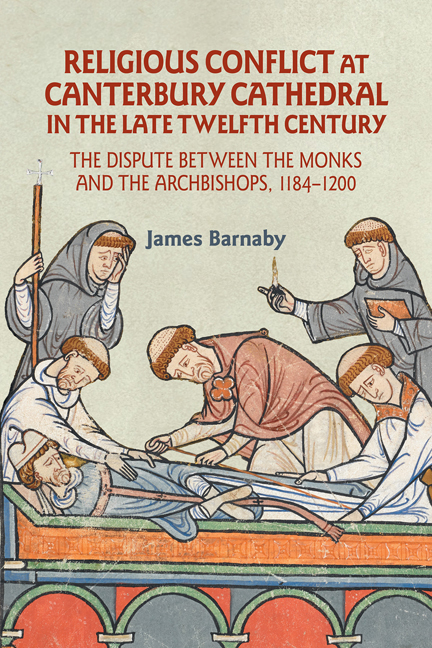 Religious Conflict at Canterbury Cathedral in the Late Twelfth Century
Religious Conflict at Canterbury Cathedral in the Late Twelfth Century Published online by Cambridge University Press: 09 May 2024
The Canterbury dispute was a complex affair. The main point of conflict concerned the erection of a new church first at Hackington and later at Lambeth, but intermixed with this conflict were also the long running disputes waged between monks and archbishops concerning lands, rights, and privileges. While it is the proposed new church that has always been given the centre ground in accounts of the quarrel, the other issues were arguably of greater importance to the monks. Although the church was a symbol of the discord between archbishop and chapter, as well as being a trigger to the prolonged period of litigation observed in the late twelfth and thirteenth centuries, it was the issues such as control of the exennia (the Christmas and Easter altar offerings from the cathedral estates) and the convent's ability to appoint its own officials, which had a greater impact on the day-to-day affairs of the monks. Yet without Baldwin's plan for Hackington, it is possible that these other problems would have merely simmered beneath the surface and would not have erupted in the twelfth century. If that had been the case, Baldwin's archiepiscopacy could have been remembered very differently.
Baldwin of Forde
Baldwin and the monks of Christ Church were at odds with each other from the beginning. He was not the monks’ choice as archbishop; they wanted either Theobald of Cluny or Odo of Battle. However, Henry II favoured Baldwin and imposed his choice on the chapter. Although not the monastic choice, Baldwin was by no means a bad person to have as a prelate. According to William of Newburgh, Henry often complained about churchmen who embraced the world with both arms. Baldwin was certainly not one of those. He was a hardworking and pious man who abandoned a promising career as a secular clerk to enter the Cistercian monastery at Forde in 1170, rising through the ranks to become abbot within a few years. In 1180, he was appointed bishop of Worcester, and four years later was translated to Canterbury. It was his actions against the Canterbury monks which gave him a poor reputation both then and now. Pope Urban III for example described him as ‘the most fervent monk, the warm abbot, the tepid bishop and the remiss archbishop’. This assessment has often been accepted by historians.
To save this book to your Kindle, first ensure no-reply@cambridge.org is added to your Approved Personal Document E-mail List under your Personal Document Settings on the Manage Your Content and Devices page of your Amazon account. Then enter the ‘name’ part of your Kindle email address below. Find out more about saving to your Kindle.
Note you can select to save to either the @free.kindle.com or @kindle.com variations. ‘@free.kindle.com’ emails are free but can only be saved to your device when it is connected to wi-fi. ‘@kindle.com’ emails can be delivered even when you are not connected to wi-fi, but note that service fees apply.
Find out more about the Kindle Personal Document Service.
To save content items to your account, please confirm that you agree to abide by our usage policies. If this is the first time you use this feature, you will be asked to authorise Cambridge Core to connect with your account. Find out more about saving content to Dropbox.
To save content items to your account, please confirm that you agree to abide by our usage policies. If this is the first time you use this feature, you will be asked to authorise Cambridge Core to connect with your account. Find out more about saving content to Google Drive.